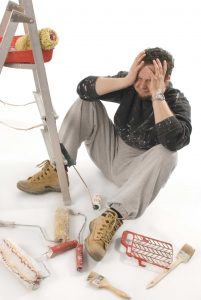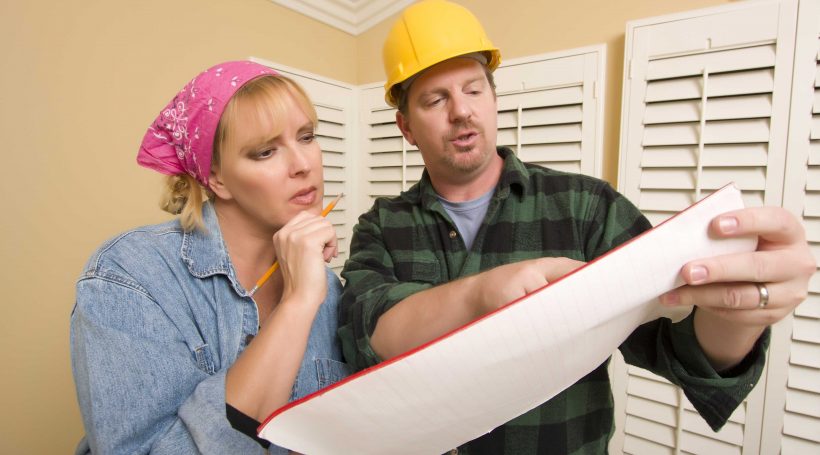On TV, Joe and Josephine Homeowner miraculously turn their tired old kitchen into a sparkling designer showcase in a mere 24 hours. And they do it on a shoestring budget. Better yet, they are energized and cheery the entire time.
So how come your home-improvement projects don’t seem to be that easy? It’s because reality TV isn’t so real, say several SJ home improvement experts. From the behind-the-scenes helpers to jobs done half-way, what you see on television doesn’t tell the whole remodeling story.
Real Costs for Real People
Unlike the do-it-yourself shows, real homeowners have to pay retail. TV shows can trade advertising – by parking a truck with a store-logo in the driveway of the home, so it appears on camera – for a deep discount on supplies. Also, most people don’t have time to fully compare prices, nor the inside knowledge to know where to get the best deals.
“Homeowners fail to make the true financial comparison between doing it themselves and hiring a professional,” says Andrew Cosello, president of Cosello Construction. “They start a job not taking into account the total cost for materials, unforeseen damages and time to complete the job. So they end up calling a contractor to complete the project, which ends up costing them more time and money.”
Beyond financial expenses is the cost in time a household project will take. TV shows typically have a full staff of workers who can remove or cover furniture, rip out old carpet and tape windows. All of these steps take time before any of the real renovation work even begins.
“The shows that most folks enjoy watching do not show the entire project from start to finish,” says Cosello. “They leave out all the legwork involved in planning the job accurately, purchasing the material and fully executing the job to completion. They focus on the easy tasks that do not require much skill and leave out the bulk of the project.”
TV viewers also don’t see inspectors signing off on plumbing and electrical work before much of the construction can even begin. “All the internal things are more costly than the finished trim and the crown molding,” adds Cosello.
Painting Takes Time
Many do-it-yourself shows often present a cute, happy couple rolling paint on the wall. But that’s the easiest part of the job, says John Ahern, president of Ahern Painting. “They should show people sanding and masking,” he quips.
 Painting is a process that requires specific steps in order for the job to be done right, he explains. The numerous steps include washing the walls to remove dirt, mildew and grease; sanding to a smooth finish, puttying any holes, caulking joints and openings, patching where necessary, masking, and putting on a prime coat. On TV, little attention is devoted to these steps, and when a second coat of paint is applied, there doesn’t seem to have been enough time for the first coat to dry.
Painting is a process that requires specific steps in order for the job to be done right, he explains. The numerous steps include washing the walls to remove dirt, mildew and grease; sanding to a smooth finish, puttying any holes, caulking joints and openings, patching where necessary, masking, and putting on a prime coat. On TV, little attention is devoted to these steps, and when a second coat of paint is applied, there doesn’t seem to have been enough time for the first coat to dry.
“You want the walls to be clean, smooth and tight,” says Ahern. “That’s how you know you’re ready to paint. No matter how much labor is present on the job, you still need time for curing and drying. Skipping one step might be the reason that job fails.”
One step rarely shown on television is protecting furniture, floors and countertops with tarps. In reality, great attention must be taken to protect existing surfaces from stray paint, says Ahern.
“We fight that perception often about speed and time,” he adds. “Sometimes the quicker you get it done, the shorter amount of time the job is going to last.”
Planning is Step One
A lot of home-renovation jobs on TV are planned before the show begins, yet that can be the most important part of the job, and the process can take a considerable amount of time. Without proper planning, a job can go wrong.
“You might end up making miscellaneous errors and mistakes, which are costly,” says Diana DiMedio, designer at Dubell Lumber. “We tell a customer what is involved in a project and what needs to be purchased, and we’ll give advice along the way,” she says. When customers are remodeling a kitchen, “we even come out to measure, so there won’t be any errors.”
Real Problems for Real People
In TV land, there are no problems. Sometimes – and only sometimes – a problem arises but is quickly and easily fixed. In reality land, problems happen, usually a lot.
“Very rarely do things go smoothly. If you don’t know what you’re doing, once you start with a problem it just snowballs,” says Bernie Butler, owner of Kitchen and Bath Gallery. He has experienced the unexpected many times, but has the expertise to develop a Plan B. He recalls one bathroom remodeling job where an eight-foot section of the floor was an inch-and-a-half out of level, creating many problems.
“You basically have to figure out ways to correct the problems and roll with the punches,” he says. “Often the average do-it-yourselfer,” says Butler, “has no idea what to do.”














